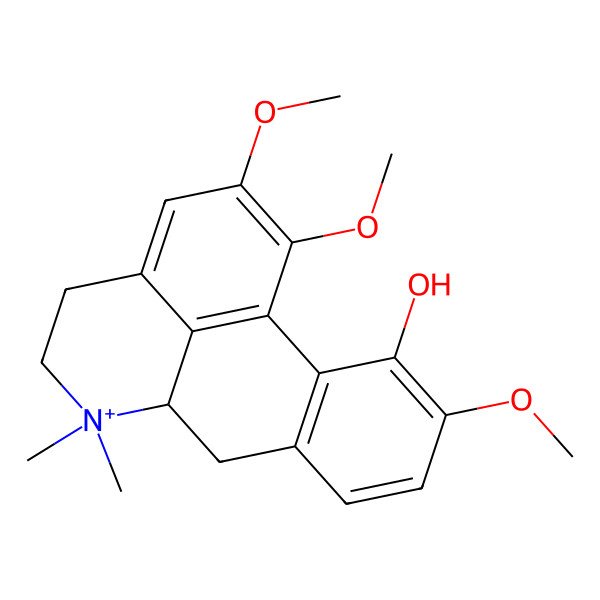Menisperine
| Internal ID | 81fddd67-d711-4e1c-a9e0-a336df487b4b |
| Taxonomy | Alkaloids and derivatives > Aporphines |
| IUPAC Name | 1,2,10-trimethoxy-6,6-dimethyl-5,6,6a,7-tetrahydro-4H-dibenzo[de,g]quinolin-6-ium-11-ol |
| SMILES (Canonical) | C[N+]1(CCC2=CC(=C(C3=C2C1CC4=C3C(=C(C=C4)OC)O)OC)OC)C |
| SMILES (Isomeric) | C[N+]1(CCC2=CC(=C(C3=C2C1CC4=C3C(=C(C=C4)OC)O)OC)OC)C |
| InChI | InChI=1S/C21H25NO4/c1-22(2)9-8-13-11-16(25-4)21(26-5)19-17(13)14(22)10-12-6-7-15(24-3)20(23)18(12)19/h6-7,11,14H,8-10H2,1-5H3/p+1 |
| InChI Key | XQINTCORIZHGFD-UHFFFAOYSA-O |
| Popularity | 5 references in papers |
| Molecular Formula | C21H26NO4+ |
| Molecular Weight | 356.40 g/mol |
| Exact Mass | 356.18618331 g/mol |
| Topological Polar Surface Area (TPSA) | 47.90 Ų |
| XlogP | 3.10 |
| Menispermine |
| CHEMBL175775 |
| 1,2,10-trimethoxy-6,6-dimethyl-5,6,6a,7-tetrahydro-4H-dibenzo[de,g]quinolin-6-ium-11-ol |

| Target | Value | Probability (raw) | Probability (%) |
|---|---|---|---|
| No predicted properties yet! | |||
Proven Targets:
| CHEMBL ID | UniProt ID | Name | Min activity | Assay type | Source |
|---|---|---|---|---|---|
| No proven targets yet! | |||||
Predicted Targets (via Super-PRED):
| CHEMBL ID | UniProt ID | Name | Probability | Model accuracy |
|---|---|---|---|---|
| CHEMBL3192 | Q9BY41 | Histone deacetylase 8 | 98.67% | 93.99% |
| CHEMBL3251 | P19838 | Nuclear factor NF-kappa-B p105 subunit | 97.54% | 96.09% |
| CHEMBL5619 | P27695 | DNA-(apurinic or apyrimidinic site) lyase | 96.39% | 91.11% |
| CHEMBL4203 | Q9HAZ1 | Dual specificity protein kinase CLK4 | 93.07% | 94.45% |
| CHEMBL1951 | P21397 | Monoamine oxidase A | 92.35% | 91.49% |
| CHEMBL241 | Q14432 | Phosphodiesterase 3A | 92.10% | 92.94% |
| CHEMBL217 | P14416 | Dopamine D2 receptor | 90.16% | 95.62% |
| CHEMBL2041 | P07949 | Tyrosine-protein kinase receptor RET | 89.85% | 91.79% |
| CHEMBL3108638 | O15164 | Transcription intermediary factor 1-alpha | 89.39% | 95.56% |
| CHEMBL1163125 | O60885 | Bromodomain-containing protein 4 | 89.12% | 97.31% |
| CHEMBL3438 | Q05513 | Protein kinase C zeta | 88.14% | 88.48% |
| CHEMBL5608 | Q16288 | NT-3 growth factor receptor | 88.04% | 95.89% |
| CHEMBL3060 | Q9Y345 | Glycine transporter 2 | 88.00% | 99.17% |
| CHEMBL2635 | P51452 | Dual specificity protein phosphatase 3 | 86.38% | 94.00% |
| CHEMBL1293249 | Q13887 | Kruppel-like factor 5 | 85.57% | 86.33% |
| CHEMBL2535 | P11166 | Glucose transporter | 85.00% | 98.75% |
| CHEMBL225 | P28335 | Serotonin 2c (5-HT2c) receptor | 84.79% | 89.62% |
| CHEMBL2056 | P21728 | Dopamine D1 receptor | 84.39% | 91.00% |
| CHEMBL2581 | P07339 | Cathepsin D | 83.35% | 98.95% |
| CHEMBL213 | P08588 | Beta-1 adrenergic receptor | 83.14% | 95.56% |
| CHEMBL3137262 | O60341 | LSD1/CoREST complex | 81.77% | 97.09% |
| CHEMBL5339 | Q5NUL3 | G-protein coupled receptor 120 | 81.31% | 95.78% |
| CHEMBL261 | P00915 | Carbonic anhydrase I | 81.30% | 96.76% |
Below are displayed all the plants proven (via scientific papers) to contain this
compound!
To see more specific details click the taxa you are interested in.
To see more specific details click the taxa you are interested in.
| Cryptocarya mandioccana |
| Magnolia grandiflora |
| Nandina domestica |
| Penianthus zenkeri |
| Phellodendron amurense |
| Rhigiocarya racemifera |
| Stephania cephalantha |
| Tinospora sagittata |
| Zanthoxylum nitidum |
| PubChem | 30358 |
| NPASS | NPC306555 |
| ChEMBL | CHEMBL175775 |
| LOTUS | LTS0076303 |
| wikiData | Q104201248 |